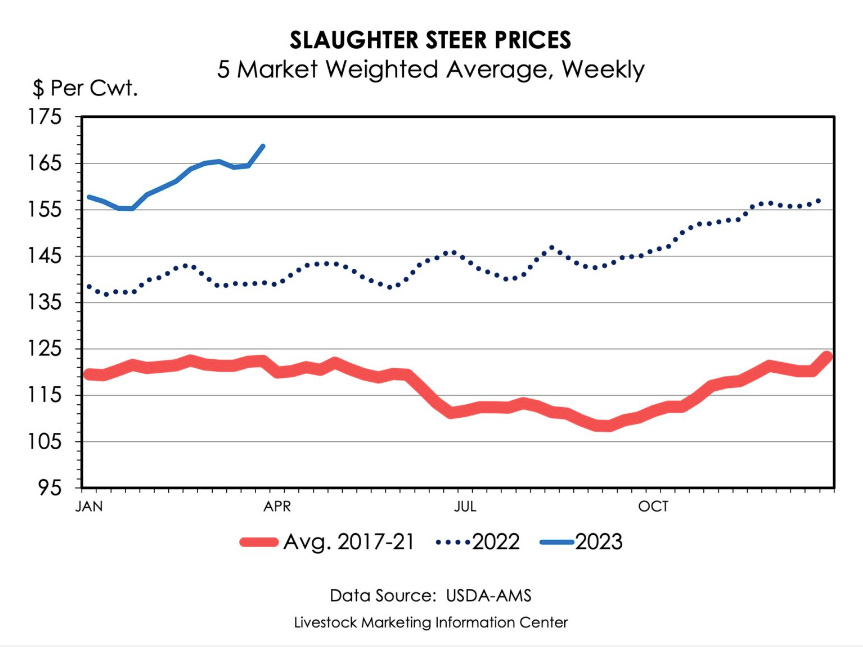LITTLE ROCK — It’s true: Cattle market prices are at what some analysts have called “historic highs.” Unfortunately, profits are not.
For the entirety of 2023, slaughtered steer prices across all U.S. markets have remained above those of the previous year by 20-30 cwt, ranging from $155 to $170, and practically soared above the 2017-2021 average by 40 cwt or more. According to recent data from the U.S. Department of Agriculture, fed steer prices reached above $175 cwt last week, topping the 2014-2015 record of about $172.
But of course, a dollar in 2023 is not what it was in 2014. According to the U.S. Bureau of Labor Statistics, inflation during those nine years has reduced the value of a dollar spent in the consumer price index by 28 cents.

James Mitchell, extension livestock economist for the University of Arkansas System Division of Agriculture, said inflation is just one reason to keep today’s market prices in perspective.
“I wouldn’t say we’re near ‘record territory,’” Mitchell said. “I’d say we have prices as high as we’ve seen in the last 10 years in nominal terms — which is still great. You have to be careful how you interpret that, however.”
Mitchell also emphasized that the cattle industry, as a whole, abides by a cyclical nature.
“We’ve had three, four consecutive years of liquidating cow herds, of tighter and tighter feeder cattle supplies, and that’s driven significantly higher,” he said. But producers shouldn’t expect that upward trend to continue indefinitely.
For cattle producers in the U.S. Southeast and elsewhere, 2014-2015 was an unforgettable season, for reasons both good and bad. Prices spiked to record highs at the end of 2014, owing largely to market demand, at a time when feed, fuel and other input prices remained relatively low. When supply began catching up, however, market competition pulled the floor out from beneath those prices, leaving many producers with larger herds they had to either maintain or sell off at much-lower-than-anticipated prices.
Mitchell said that today’s high input prices, while largely the bane of many producers’ existence, will at least help sustain the cattle market prices.
“All the inputs are much higher than they were 10 years ago,” he said. “Corn is still high, fertilizer is still high, fuel is still high. So, because profitability hasn’t moved up as high as prices have, I do think we’re going to see prices stay high for a more prolonged period amount of time. When we got into the fall of 2015, it seemed like prices just fell out from under us, and we continued along that path for the next couple of years.”
As always, spring and summer weather will play the wild card in cattle production. While Arkansas has seen a fairly wet few months, that augers nothing for the summer, when rainfall will be more critical for providing grazing material to livestock.
“We’ve been pretty fortunate in Arkansas, but I’d argue that moisture really doesn’t matter now as much as it does in the next few months,” Mitchell said. “We need timely, adequate rainfall through the spring and summer, when it matters most for both forage production and hay production. It doesn’t matter a whole lot if we’ve got rain in February and March.”
Even if Arkansas does see a dry summer, the state’s cattle producers still have a lead on some neighboring states that have dwelled in the doldrums of drought for more than a year now.
“We still have two of our biggest cattle states, Oklahoma and Texas, that are still very much in drought, so that’s limiting the options for a lot of those producers,” Mitchell said. “Kansas is in even more of a severe drought scenario.
“The prices may be high, but if we don’t have grass to feed cattle, there’s nothing we can do about it,” he said.
To learn about extension programs in Arkansas, contact your local Cooperative Extension Service agent or visit
www.uaex.uada.edu. Follow us on Twitter and Instagram at @AR_Extension. To learn more about Division of Agriculture research, visit the Arkansas Agricultural Experiment Station website: https://aaes.uada.edu/. Follow on Twitter at @ArkAgResearch. To learn more about the Division of Agriculture, visit https://uada.edu/. Follow us on Twitter at @AgInArk.
About the Division of Agriculture
The University of Arkansas System Division of Agriculture’s mission is to strengthen agriculture, communities, and families by connecting trusted research to the adoption of best practices. Through the Agricultural Experiment Station and the Cooperative Extension Service, the Division of Agriculture conducts research and extension work within the nation’s historic land grant education system.
The Division of Agriculture is one of 20 entities within the University of Arkansas System. It has offices in all 75 counties in Arkansas and faculty on five system campuses.
The University of Arkansas System Division of Agriculture offers all its Extension and Research programs to all eligible persons without regard to race, color, sex, gender identity, sexual orientation, national origin, religion, age, disability, marital or veteran status, genetic information, or any other legally protected status, and is an Affirmative Action/Equal Opportunity Employer.


